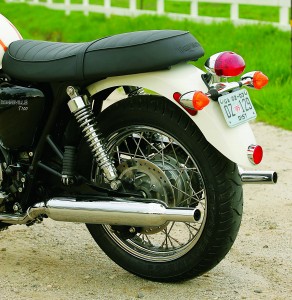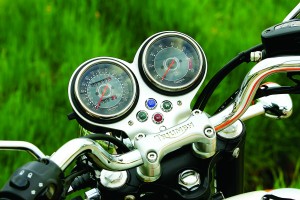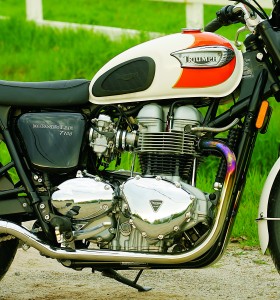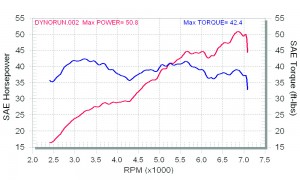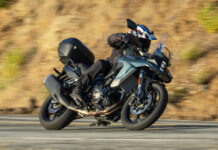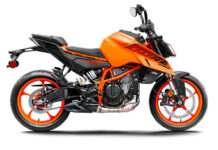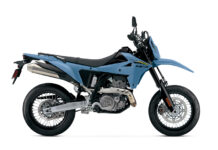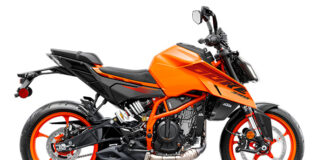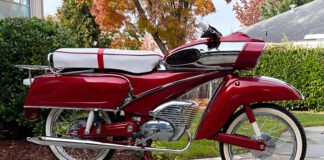Considering how much time and energy Americans expend acquiring the latest gadgets and gizmos, we also go to an enormous amount of effort trying to relive our past. For example, count the late-model American production cars that look like street rods from the 1950s, or walk through any Harley showroom, and you’ll see America’s youth on wheels, or at least the evocation thereof, for sale.
For a certain segment of older motorcyclists, the Triumph Bonneville was the touchstone of that youth. A light, narrow, torquey British twin that handled like a dream and could be a nightmare to keep running, the original Bonnie defined motorcycling at its most elemental for an entire generation. The newest incarnation of this iconic motorcycle, a product of the Triumph Motorcycles Limited reborn in 1990, is the 2005 Bonneville T100, and it proves that while you can’t relive the past, you can build a better one in the present.
The T100’s lines mimic those of its classic ancestor so faithfully that when the question, “What year is your Triumph?” is asked-and it will be, often-the answer will almost always cause the questioner’s eyes to widen in surprise. Triumph did a marvelous job evoking the classic Bonneville powerplant with a rounded valve cover and subtly shaped engine covers that suggest rather than imitate the original. But underneath those covers lies a thoroughly modern powerplant with dual overhead cams, four valves per cylinder and a shim-over-bucket valve train that requires service only every 12,000 miles. Gone, too, are the finicky, incontinent Amals of old, replaced by a pair of 36mm Keihin CVs with heating elements that warm the intake tract at ambient temperatures under 50 degrees.
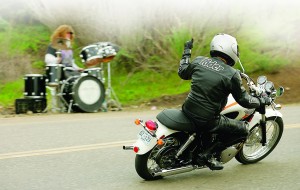
In what some might think an unwise nod to tradition, the forged, plain-bearing crankshaft’s pistons rise and fall together. It’s an arrangement that afflicted countless British vertical twins with hand-numbing, foot-tingling, tooth-loosening vibration-but not the T100, thanks to two gear-driven counterbalancers that tame engine vibration to an almost magical degree. Another touch of modernity is mounted below the steering head, a large oil cooler that helps keep the 865cc air-cooled engine happy. A gear-driven wet clutch and a five-speed gearbox direct power to the rear wheel through an X-ring chain.
Compared to the high-tech extruded aluminum frames used by some bikes today, the T100’s conventional double-downtube steel cradle frame and twin-shock swingarm look quaint. The T100’s suspension is similarly low-tech, consisting of a non-adjustable damper-rod front fork and a pair of preload-adjustable rear shocks. Chrome steel rims laced to aluminum hubs wear Metzeler tires, a 100/90-19 ME33 in the front and a 130/80R-17 MEZ2 in the rear. On each wheel is a single disc brake clamped by a two-piston caliper.
The instrument cluster is basic, with a vintage-faced speedo and tach atop turn-signal, oil-pressure, high-beam and neutral-indicator lights. At either end of the 1-inch-diameter handlebar are switch boxes that look nothing like the Lucas units of unlamented memory, but are instead rounded, sleek and functional. The relatively narrow handlebar leaves the mirrors tucked in too close for an unobstructed rearward view around the shoulders of larger riders.
The retro theme hits a minor sour note when you thumb the engine to life and the mufflers emit a subdued purr, reminding you that it’s 2005, not 1969, and that the intervening years have criminalized the original Bonnie’s roarty exhaust note. All is forgiven, however, as soon as you let out the clutch and head down the road. Across the gap in time between the old Triumph’s death at Meriden and the new company’s rebirth at Hinckley, the gene for torque survived. From idle on up, the T100 pulls willingly, with nary a bump or dip anywhere in the powerband. Below 5,000 rpm the engine counterbalancers banish vibration to such a degree that you have to keep looking down at the gorgeous Triumph logo milled into the handlebar clamp to remind yourself this is indeed a British vertical twin.
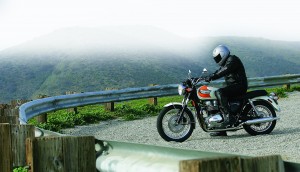
Above 5,000 rpm the grips begin to buzz and the mirrors start to fuzz, and it gets worse the nearer the 7,000-rpm redline looms, although it’s so mild compared to the frantic shaking veteran Triumph fans remember that they likely won’t even notice it. But in truth there’s little need to push the needle that far around the tach unless you’re passing slower traffic. You can ride the T100 all day under 5,000 rpm, short-shifting in the meat of the torque band, and never miss the five-digit redlines of higher-revving, higher-strung bikes. The revs build so progressively that you can roll on the gas midcorner and not worry about dips or surges in the power delivery upsetting the chassis. The engine is very forgiving, too-if you find yourself a gear too high in a turn and don’t want to downshift, just dial in some throttle. Unlike some bikes that buck or stumble at low revs under load, the T100 just claws its way smoothly back into the powerband without complaint.
The T100’s high-rpm performance isn’t going to make you forget the last in-line four-cylinder sportbike you rode, but there’s enough on tap to let you pretend your favorite backroad is the Isle of Man-as well as uncover some inadequacies in the bike’s suspension and brakes. The damper-rod fork has too much compression damping, and sends short, sharp shocks to your arms and shoulders over rough-edged bumps. The rear shocks have the opposite problem, too little rebound damping, and after a couple of big whoops in a row it sometimes takes two or three oscillations before they settle down.
The disc brakes have more than enough power around town and for casual riding and great feel thanks in part to steel-braided Teflon brake lines. The front brake lever-and the clutch lever, too-is adjustable to four positions. But the faster you go and the hotter the brakes get, the more wooden the front one feels, and the harder a squeeze it requires to get the same response-and the more fork flex you get in the bargain. The rear brake becomes more important the faster you go, contributing to short stops to a greater degree than is the case on bikes with dual front discs.

If you want to know how British twins earned their reputation for superb handling, just lean the T100 into a corner. With its conservative front-end geometry and heavy 19-inch front wheel, initiating a turn takes a bit more effort than on bikes with more sporty numbers, and it happens a bit less quickly, but does so in such a linear fashion-no dropping suddenly into the corner, just rolling smoothly into it, more like flying than riding-that you can’t help but wonder why all bikes don’t handle like this.
Rides will necessarily pause at about the 100-mile mark while you switch the manual, non-vacuum petcock to reserve. Test mileage averaged 34.3 mpg, which with the 4.4-gallon tank’s fuel load will give you 151 miles to either find gas or find out exactly how easy it is to push the T100. Frequent gas stops aren’t as much of a hardship as you might think, however, because the seat, though stylish, is hard and narrow and slightly crowned in the middle. The comfortably sit-up riding position shines around town, but on longer rides at elevated speeds quickly becomes tiring. The seat-to-footpeg distance is either compact or cramped, depending on the length of your legs and the flexibility of your knees. The passenger pegs are a solo rider’s best friends on the slab.
Like its ancestors, the T100 has quirks of its own. It lacks a decent toolkit, for example, and the tool to remove the bolt-on seat or side cover is‚ under the side cover. A centerstand is also not included in the T100’s base price, but is instead a $240 option.
These shortcomings fade into the background on a gently winding road, with the T100’s engine purring underneath the narrow tank, as you poke one knee to the inside of the corner as if you were blasting down a narrow country lane bordered by hedges on your way to meet your mates at the local pub.
What niche does the T100 fit into? Hard to say. It doesn’t really have the range to tour on, or the power to go up against sportbikes, or the glittery faux-hip styling of a cruiser. And yet it’s too good to be classed as just a retro bike, because once you look past the homage to its ancestry, it’s an honest-to-goodness motorcycle, embodying the virtues of the classic British vertical twin-light weight, good handling, sufficient power and simplicity of design. The T100 shows you there’s no need to choose between the past and the present when you can have the best of both in one motorcycle.
If you’re interested in the 2005 Triumph Bonneville T100, you may also be interested in Rider‘s: 2009 Triumph 50th Anniversary Bonneville review, or our 2009 Triumph Bonneville SE review.

